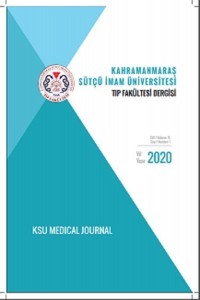Tüp, İkiz ve Üçüz Bebeklerin TEOAE ve Latans Sürelerinin Karşılaştırılması
yenidoğan, işitme tarama, TEOAE, latans süresi
Comparison of TEOAE and Latency Times of Tube Babies, Twins and Triplets
newborn, hearing screening, TEOAE, latency time,
___
- 1. Jakuhimura J, Kabatova Z, Pawlowcinova G, Profant M. Newborn hearing screening and strategy for early detection of hearing loss in infants. Int J Pediatr Otorhinolaryngol 2009;73(4):607-12.2. Prieve BA, Hancur-Bucci CA, Preston JL. Changes in transient-evoked otoacoustic emissions in the first month of life. Ear Hear 2009;30(3):330-9.
- 3. Jedrzejczak WW, Hatzopoulos S, Martini A, Blinowska KJ. Otoacoustic emissions latency difference between fulterm and preterm neonates. Hearing Research 2007;231:54-62.
- 4. Moleti A, Sisto R, Tognola G, Parazzini M, Ravazzini P, Grandori F. Otoacoustic emission latency, cochlear tuning, and hearing functionality in neonates. J Acoust Soc Am 2005 2005;118(3):1576-1584.5. Mc Fadden D, Loehlin JC. On the heritability of spontaneous otoacoustic emissions: A twin study. Hearing Research 1995;85(1-2):181-98.
- 6. Thornton AR, Marotta N, Kennedy CR. The order of testing effect i otoacoustic emissions and its consequences for sex and ear differences in neonates. Hearing Research 2003;184:123-130.7. Tognola G, Parazzini M, Jager P, Brienesse P, Ravazzani P, Grandori F. Cochlear maturation and otoacoustic emissions in preterm infants: a time-frequency approach. Hearing Research 2005;199:71-80.8. Keefe DH, Bulen JC, Arehart KH, Burns EM.Ear-canal impedance and reflection coefficient in human infants and adults.J Acoust Soc Am 94(5):2617-38.
- ISSN: 1303-6610
- Yayın Aralığı: Yılda 3 Sayı
- Başlangıç: 2004
- Yayıncı: Kahramanmaraş Sütçü İmam Üniversitesi
Hiperlipidemi ve Erektil Disfonksiyon
Hüseyin ÖZTARAKÇI, Saime SAĞIROĞLU, Mehmet Akif KILIÇ
Tüp, İkiz ve Üçüz Bebeklerin TEOAE ve Latans Sürelerinin Karşılaştırılması
Çocukta Serebral Tutulumun Eşlik Ettiği Kardiyak Kist Hidatik: Olgu Sunumu
Aydın TUNÇAY, Ömer Naci EMİROĞULLARI
Diyare ile Başvuran Kırım Kongo Kanamalı Ateşi Olgusu
Hüseyin GÜMÜŞ, Halil KAZANASMAZ
Metin KILINÇ, Hatice SAĞER, Eda GANİYUSUFOĞLU, Yeliz DOBOĞLU, Nazlı ÜLKER HANÇER
